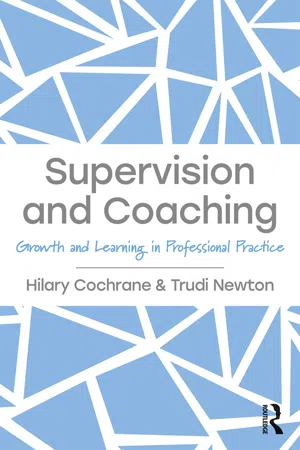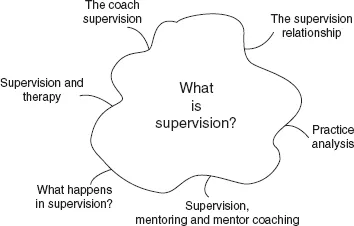![]()
Chapter 1
What is supervision?
The start of a supervision session is like the opening of a show: you’ve looked at the programme and the house lights have gone down; the red velvet curtains draw back, but all you can see is a shallow strip of stage with another painted curtain behind it, a static image holding the possibility of something beyond it – but not the reality.
And, then, as the lights shine behind this curtain, you see that it is in fact a gauze – and revealed behind it are the players, the action, the full depth and perspective of the stage. Now we have something worth engaging with.
And this is how it is in supervision: we reveal what lies behind the static, two-dimensional image. This is our territory – this is where we want to explore.
The theatre metaphor describes an experience we willingly enter into, that contains layers of both illusion and reality. It will never, ever, be the same twice. What we see on the stage can’t be repeated because both the characters and their audience are developing moment by moment. We are in a relationship where both parties are changed by their here-and-now experience.
Theatre is built on the creation of a version of reality but is in fact a mystery. When you pull back the curtains and turn on the bright white working lights you can see how all of that experience has been created by the technicians and the actors with wood and metal, nuts and bolts, rope and fabric, sound and light. It isn’t mysterious any more; it all makes complete sense. You have moved from the limited perspective of the audience into a wider dimension of understanding – making sense of the experience and how it has been created.
Like our engagement with the theatre, once we’ve realised what’s happening on the stage, in supervision we want to know how each of the elements of the story has come to be – the intention of the relationship, the interaction between client, coach, supervisor and the wider system – and to understand how we have created our own response to it.
And, yes, there are many elements here, and it will take a lot of work to understand them all. But at each stage in our exploration, more is revealed to enrich us and help us develop the way we want to work in the future. We begin to grasp what is easy for us, what we think we may never understand, the bits we love to get to grips with and those where we might rather have stayed with our illusions.
So, just like the theatre, things are revealed stage by stage – as we’re ready.
We all grow best when we feel safe enough to be challenged, safe enough to be adventurous, safe enough to disclose and admit mistakes – when we’re not afraid of exposure. We grow best where equality is present and power is available to each and appropriately deployed – where responsibility can be negotiated and promises made and held to. In such a relationship, what was opaque can become clear and what has been in the darkness can be enjoyed in the light.
The supervision relationship
Supervision essentially describes a relationship between two practitioners, both of whom are working in the field of professional personal development. When this relationship includes trust and mutual respect it enables each of the participants to have the courage to celebrate who they are and what they are proud of – and to confront and resolve those aspects that cause them to experience defensiveness, disappointment, shame, frustration and even grief.
This is not rescuing or befriending or comforting (all of which may sometimes show up in supervision) because this relationship is clearly contracted and re-contracted for throughout its lifetime. For it to truly work both parties need to be willing to be vulnerable – to not know, to be confused or lost – whilst on the journey to clarity and progress.
For each partner in the supervision relationship all of their learning flows from within that relationship. If ‘how we work is who we are’, then supervision needs to be about supervisor and supervisee jointly questioning the way in which ‘who the supervisee is’ is manifested in ‘how they work’. And as we begin to develop ‘how we work’, ‘who we are’ will also grow.
This is how learning happens: all the thinking that has happened on our supervisor training courses has contributed to our recognition that supervision is ‘learning in relationship’; a place to create an understanding that can be taken back into those other, workplace, relationships.
At its best, we think the supervision relationship is:
•a place of empathy and rigour; a place of possibility and safety, without personal judgement;
•a place where both partners can be truthful;
•a collegial relationship where there is authenticity, a balance of power, and both parties are absolutely accepted;
•a place where there is joy in learning and no fear of disclosure;
•a place where learning is noticed and recognised, and competence is brought into awareness.
This, then, is the real essence of ‘how we work is who we are’.
The supervision relationship happens within a contract which combines rigour and empathy. This contract will be the ‘container’ for the relationship, defining its purpose and nature: what it is – and what it is not.
Without the rigour of a clear contract, how do we know what we are setting out to achieve – or if we have achieved it? How do we know whether we have an ethical dilemma or not? How can we be sure we are doing something truly and professionally valuable, as opposed to simply colluding when we meant to nurture, undermining when we meant to challenge, controlling when we meant to manage?
Without an empathic relationship, how can we create the conditions of trust and mutual understanding which both allow and enable real learning?
The key to the supervision relationship, and the work that is possible within it, is to create a robust balance between the ‘container’ (a clear and structured contract) and the ‘content’ (the empathic understanding and intuition which allow ‘leaps of learning’).
What happens in supervision?
Coaching has rapidly become established and recognised as a profession. Supervision, as an accepted part of that professionalisation process, is relatively new.
As the coaching world grows, so there is an increasing need for a body of well-trained, informed practitioners who understand the ethics, responsibilities, practices and defining features of this developing profession. Accountability to clients, organisations and the coaching profession is a major aspect of our view of coach supervision, creating an ongoing dialogue between the personal and the professional, the relationship and the responsibility.
Coaching supervision aims to locate when, how and why the personal (the coach’s stuff) intrudes into the professional (the space in which coach and client are working). What does this reveal to both coach and supervisor about where change and growth need to occur in order to better serve the clients? It may well be that what happens between supervisor and coach also points to learning – so the relationship itself can be a vehicle for growth.
Mentoring and professionalisation
At first, the coach supervisor pool tended to be filled by coaches who had become senior in the coaching profession and felt they had the expertise (and the life experience and wisdom) to contribute to those following in their footsteps. This was most often described as ‘mentoring’ and was hugely helpful in bringing new coaches up to a professional standard of competence.
A less helpful element was that, in some cases, the mentoring relationship was based on a belief in expertise that had remained unchallenged and unmodified over the years. Unless the supervisor had had their own experience of being supervised, there was little examination of the coach’s internal world and the impact of their own filters and experiences on the way in which they worked with their clients.
There may have been little awareness of using the supervisor’s own internal experience as a ‘lens’ through which to gain understanding of what was going on in the various client relationships under observation.
About ten years ago, supervisors began to see their role as one of building a relationship of mutual challenge, vulnerability and development. They were now willing to be ‘the one who is stronger and wiser in the moment’, but they contained this within the humility to know that the other is truly the expert on themselves; they need to be supported in their growth but not told how to grow.
Supervision and motivation
Today, more coaches want to train professionally as supervisors and see it as a way of improving their own practice. There is also an emerging group of those who only want to be supervisors – and not work at all as coaches.
S...

